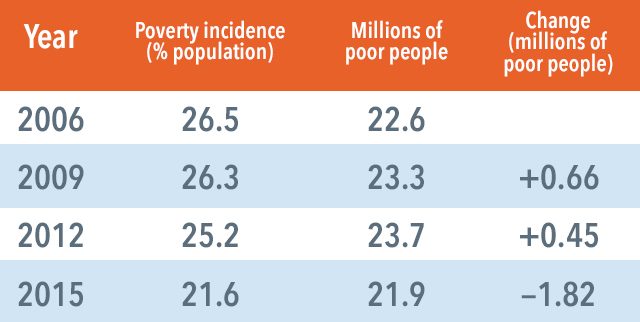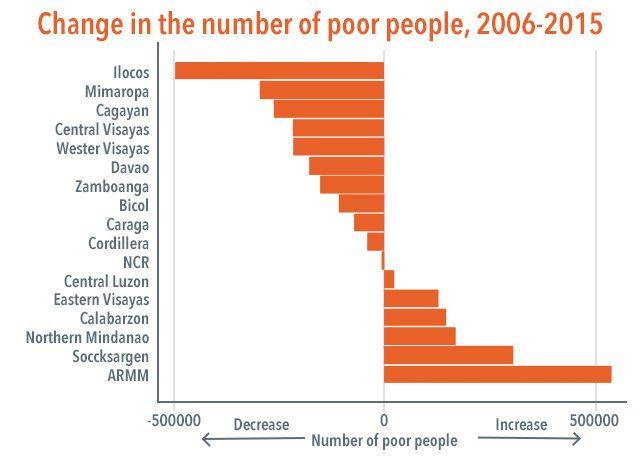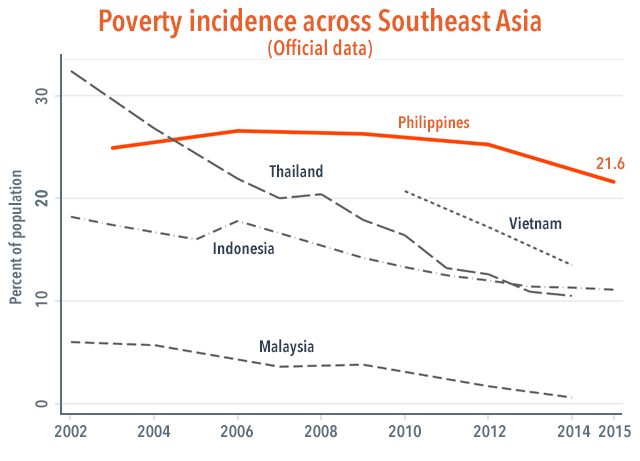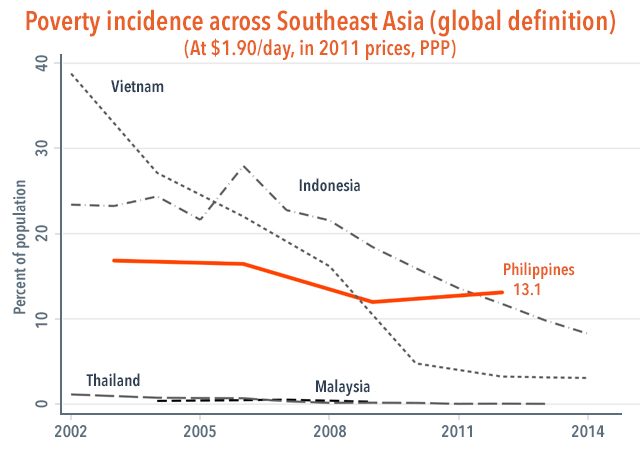SUMMARY
This is AI generated summarization, which may have errors. For context, always refer to the full article.

(UPDATED) This week the government announced a monumental achievement in the country’s fight against poverty. As of 2015, only 1 in 5 Filipinos can be considered poor (or 21.6% of the population).
This is remarkable since just 3 years earlier (or in 2012), around 1 in 4 Filipinos was poor (25.2% of the population). In other words, the country was able to reduce the number of poor Filipinos by 1.8 million in just a span of 3 years, from 2012 to 2015.
In this article we show that the 2015 official data can reveal a few more insights about the pace of poverty reduction in the country.
In particular, we show that over the past decade (2006-2015) the reduction in the number of poor people was actually quite small, owing to a higher number of poor people in Mindanao. Furthermore, we show that our poverty reduction record continues to pale in comparison with our regional neighbors.
Magnitude of poverty
Let’s start with the basic facts. Table 1 below shows that the poor’s share to the population (otherwise known as “poverty incidence”) has continuously declined from 2006 to 2015.
At the same time, however, the number of poor people actually went up from 2006-2009, and again in 2009-2012. It was only between 2012-2015 that the number of poor people went down.

Hence, over the 9-year period between 2006 and 2015, we reduced the number of poor people only by 0.72 million (or around 717,000 individuals). This is rather disappointing: over the course of almost a decade, this translates to a yearly reduction of the number of poor people by just 80,000 per year.
Why was poverty reduction quite small from 2006 to 2015? First, it could be partially explained by a simple technicality of the data. Since the 2006 and 2015 poverty estimates are based on different population projections, they may not be strictly comparable.*
Nonetheless, a string of man-made and natural crises could plausibly explain why the number of poor people increased between 2006 and 2012. These include the 2007 rice price crisis, the 2008-2009 global economic crisis, and major disasters like Super Typhoon Pablo in 2012.*
Hence, in order to see a more significant reduction of poverty in the future, it would be best to have a continuous decline in the number of poor people. This can be done, for example, by minimizing the risks faced by the poor, avoiding runaway inflation, increasing the scope of social protection programs, and improving disaster preparedness.
Poverty across the regions
To further understand the poverty data, it may help to examine the relative performance of the different regions.
Figure 1 shows that some regions fared better than others in reducing the number of poor people. Among the most successful in this regard were the Ilocos Region, Mimaropa, and Cagayan Valley. On the other hand, the number of poor people actually went up in other regions, notably in ARMM, Soccksargen, and Northern Mindanao.
Hence, from 2006 to 2015, Luzon reduced its poor people by 1 million people, and the Visayas by 302,000. But in Mindanao there were 616,000 more poor people in 2015 than in 2006.
Again, bear in mind the technical issue that may make the 2006 and 2015 figures not strictly comparable. Nevertheless, these and other data underscore the need to focus a large part of the country’s poverty reduction efforts on Mindanao, where development continues to be hindered by low rates of investment, toxic local politics, and frequent armed conflicts.*

Poverty in neighboring countries
Despite gains in 2015, the country’s track record of poverty reduction continues to pale in comparison with our regional neighbors.
Figure 2 shows the official poverty rates for the Philippines, Indonesia, Thailand, Vietnam, and Malaysia from 2002 to 2015. While poverty incidence has fallen in the Philippines, it has fallen much faster in our neighbors. Malaysia is closest to eliminating poverty (with a near-zero poverty rate), while Thailand, Vietnam, and Indoensia experienced impressive reductions in recent years.

But note that the data in Figure 1 are based on each country’s own definition of poverty, and hence may not be necessarily comparable. Thankfully, there exists another set of data curated by the World Bank which allows for a comparison of poverty rates across countries.
Figure 3 shows comparable poverty rates between the Philippines and its neighbors, using the most commonly cited poverty threshold of $1.90 per day. Again, as of 2012, the Philippines has the highest incidence of poverty among these countries.

Moreover, the comparable data reveal an even more dramatic decline of poverty in our neighbors. In Vietnam, starting at a very high 39% in 2002, the poverty rate went down to 3% as of 2014 – a dramatic 36 percentage point reduction in just 12 years!
Remember that from 2010 to 2015, the Philippines experienced an average economic growth rate of 6.2% – the highest since the mid-1970s. But despite such spectacular growth performance, the World Bank data attest to the stubbornness of Philippine poverty. Hence, the challenge faced by our incumbent leaders is making poverty reduction more responsive to growth in the years to come.
Conclusion: Can we eradicate poverty by 2040?
Full-year poverty data for the Philippines are reported only every 3 years. Hence, news of the 2015 poverty data – which tells us of a record low of poverty incidence – can be rightly considered a milestone in the country’s fight against poverty.
And yet a further parsing of available data shows that over the past decade poverty has not fallen fast enough. Certain regions of the country – especially those in Mindanao – need extra help in their poverty reduction efforts. Finally, the country’s record of poverty reduction has yet to match the spectacular performance seen in our regional neighbors.
Needless to say, the country continues to face a daunting poverty challenge. As of 2015 there remain about 22 million poor Filipinos. The problem is so large that some are calling for a “War on Poverty” on the same scale as President Duterte’s “War on Drugs”.
Thankfully, the President has made poverty reduction one of his key economic reform priorities. And as noted by NEDA, the President has given the marching orders to make sure that poverty is eradicated by 2040. This is based on the 25-year vision for Philippine development called “Ambisyon Natin 2040”, crafted by NEDA and based on numerous consultations and surveys nationwide.
With the people’s vision in mind, we have our work cut out for us. For as long as we sustain the country’s growth momentum and put in place policies that make growth more inclusive, then we’ll have a reasonably good chance of finally eradicating poverty by 2040, if not sooner. – Rappler.com
*Editor’s Note: As requested by the author, edits were made in the previous version of this piece for greater clarity.
The author is a PhD student at the UP School of Economics. His views are independent of the views of his affiliations. Thanks to NEDA Deputy Director-General Rosemarie Edillon for clarifications on the poverty magnitude data, as well as to Kevin Mandrilla (UP Asian Center) for helpful comments and suggestions.
Add a comment
How does this make you feel?
There are no comments yet. Add your comment to start the conversation.